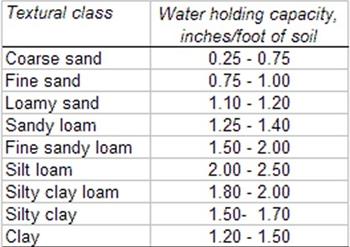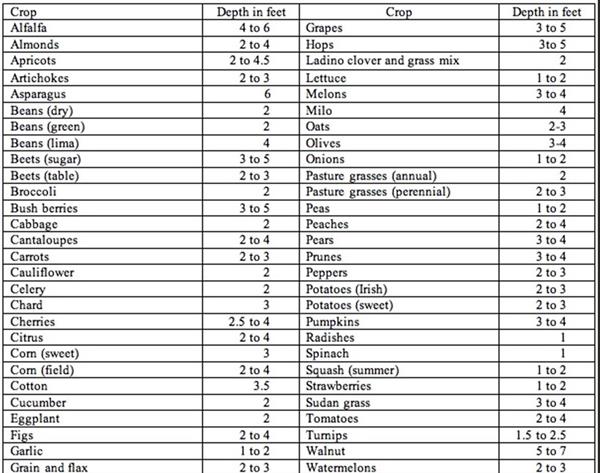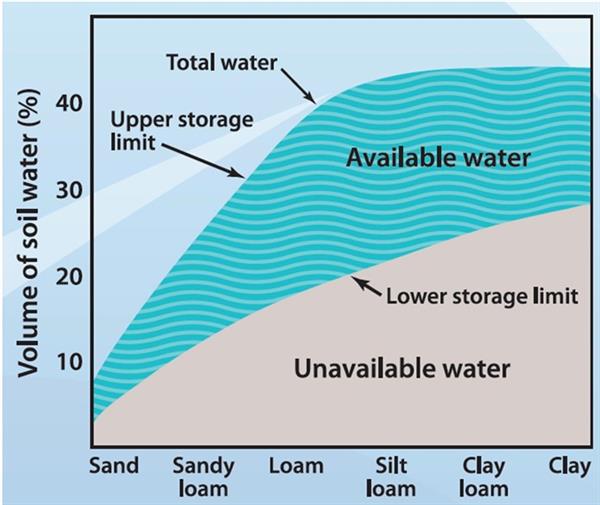
In Arizona agriculture, we have the benefit of generally working with good soils that exist in alluvial valleys or the terraces immediately adjacent to the alluvial valleys, e.g. the mesa areas. Arizona soils are geologically young and fertile but often have high levels of salinity and often sodicity. When reclaimed and properly managed with adequate leaching, we can reduce the salinity to manageable levels to support crop production systems. In the case of sodic conditions, appropriate amendments are needed then followed by adequate leaching.
In the process of applying an irrigation in the field, it is important to recognize that not all soils are created equal. Soil types vary across the landscape and they also vary by depth for any site or location. This is particularly true for alluvial soils which originate from water deposition over time, such as from the Gila and/or Colorado River systems. The soils of the lower Colorado River valleys are great examples of alluvial soils and the high degree of variability we commonly experience in the field. With some crops, particularly more deeply rooted crops, we can sometimes nearly map the soil types across a field based on crop growth patterns. Accordingly, this type of soil variability creates some challenges for in-field management, including irrigation management.
Many of the rotation crops common to the lower Colorado River Valleys, such as cotton, wheat, and sudan; are excellent examples of crops that can express growth patterns as a function of soil texture, which is clearly demonstrated in response to water stress. The courser textured parts of the field will stress earlier and consistently have reduced plant vigor. Anyone driving a tractor for medium to heavy tillage operations in the field will literally feel soil textural changes and anyone harvesting those fields will see it as well. The GPS field mapping systems can detect and record these areas of soil type differences through yield monitors as well in response to crop growth and vigor.
Soil textures vary in terms of water holding capacities and it is important to understand the dominant soil textures in the field, not only on the surface but also through the depths of the soil profile and the effective rooting depth of the crop, Tables 1 & 2 and Figure 1. To manage a complete field or set of fields, it is necessary to determine a functional “average” of soil texture and water holding capacity.
In the process of irrigation, we are attempting to replenish the soil-water extracted by the crop through evapotranspiration (ETc). In previous articles, the determination or estimation of crop ETc has been discussed.
Therefore, with irrigation management it is important to know the fields we are working with in terms of the dominant soil textures present, the degree of variability that exists, and the general water-holding capacity of the soils. Matching irrigation timing and volumes for each event to replenish the plant-available water for each field is important in our efforts to avoid water stress and achieve and maintain irrigation efficiency agronomically, which is providing the amount of water necessary to replenish the soil-water to field capacity with some degree of additional water needed for the leaching of soluble salts.
With the high degree of variability that is common among soils in the lower Colorado River Valleys, it is both important and challenging to know the soil characteristics common in each field, the water holding capacity of the dominant soils, and the level of soil-water depletion that is being replenished with each irrigation event.

Table 1. Soil texture and water holding capacity.

Table 2. Depths to which the roots of mature crops will deplete the available water supply when grown in a deep permeable, well-drained soil under average conditions. Source: Chapter 11, "Sprinkler Irrigation," Section 15, Natural Resources Conservation Service National Engineering Handbook

Figure 1. Soil volume, soil texture, and water holding capacity relationships.
Engineering Handbook.
Hi, I’m Chris, and I’m thrilled to be stepping into the role of extension associate for plant pathology through The University of Arizona Cooperative Extension in Yuma County. I recently earned my Ph.D. in plant pathology from Purdue University in Indiana where my research focused on soybean seedling disease caused by Fusarium and Pythium. There, I discovered and characterized some of the first genetic resources available for improving innate host resistance and genetic control to two major pathogens causing this disease in soybean across the Midwest.
I was originally born and raised in Phoenix, so coming back to Arizona and getting the chance to apply my education while helping the community I was shaped by is a dream come true. I have a passion for plant disease research, especially when it comes to exploring how plant-pathogen interactions and genetics can be used to develop practical, empirically based disease control strategies. Let’s face it, fungicide resistance continues to emerge, yesterday’s resistant varieties grow more vulnerable every season, and the battle against plant pathogens in our fields is ongoing. But I firmly believe that when the enemy evolves, so can we.
To that end I am proud to be establishing my research program in Yuma where I will remain dedicated to improving the agricultural community’s disease management options and tackling crop health challenges. I am based out of the Yuma Agricultural Center and will continue to run the plant health diagnostic clinic located there.
Please drop off or send disease samples for diagnosis to:
Yuma Plant Health Clinic
6425 W 8th Street
Yuma, AZ 85364
If you are shipping samples, please remember to include the USDA APHIS permit for moving plant samples.
You can contact me at:
Email: cdetranaltes@arizona.edu
Cell: 602-689-7328
Office: 928-782-5879
Plans are firming up for the 2nd Automated Weeding Technologies Field Demo Day. We have penciled in an event date of Thursday, October 21st. The focus this year will be on the latest automated weeding technologies that are “new” since our 2018 event. I’ve been reaching out to multiple companies but am sure I’m not aware of all the cutting-edge technologies out there. We would love to showcase as many innovations as possible, so please contact me if you are interested in demoing your equipment or know someone that is. It’s an open invitation - private companies, and university and government researchers are all welcome!

Malva (malva parviflora) is one of the oldest and most pervasive weeds that that we deal with here. It is also known as little mallow or cheeseweed and is in the same family as cotton, okra and hibiscus. It is often classified as a winter annual but survives all year in this region. It has a deep taproot and can grow in compacted clay or sand and in freezing conditions and high temperatures It provides a refuge for insects and diseases that can damage several crops.
Malva is easy to identify both as a seedling and mature plant. The seedlings are distinctively heart shaped and the mature plant is broad and palm shaped. It is very vegetative and can grow to 6 ft.
The deep tap root of this weed makes it difficult to cut out after it is established. Its response to herbicides id somewhat unusual. It is very sensitive to contact herbicides that do not move into the plant. These include Goal, Sharpen Gramoxone , Rely,Aim and others. However, it is not sensitive to systemic herbicides like 2,4-D and Glyphosate. It reproduces from seed and can be controlled preemergence with many of the same preemergence herbicides used in cotton like Prowl or Treflan. The seed pods are wheel shaped which is where the name cheeseweed comes from. Each seed pod contains 10 to 12 seeds

This time of year, John would often highlight Lepidopteran pests in the field and remind us of the importance of rotating insecticide modes of action. With worm pressure present in local crops, it’s a good time to revisit resistance management practices and ensure we’re protecting the effectiveness of these tools for seasons to come. For detailed guidelines, see Insecticide Resistance Management for Beet Armyworm, Cabbage Looper, and Diamondback Moth in Desert Produce Crops .
VegIPM Update Vol. 16, Num. 20
Oct. 1, 2025
Results of pheromone and sticky trap catches below!!
Corn earworm: CEW moth counts declined across all traps from last collection; average for this time of year.
Beet armyworm: BAW moth increased over the last two weeks; below average for this early produce season.
Cabbage looper: Cabbage looper counts increased in the last two collections; below average for mid-late September.
Diamondback moth: a few DBM moths were caught in the traps; consistent with previous years.
Whitefly: Adult movement decreased in most locations over the last two weeks, about average for this time of year.
Thrips: Thrips adult activity increased over the last two collections, typical for late September.
Aphids: Aphid movement absent so far; anticipate activity to pick up when winds begin blowing from N-NW.
Leafminers: Adult activity increased over the last two weeks, about average for this time of year.







